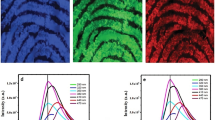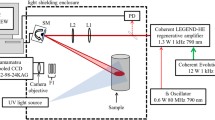Abstract
Latent fingerprint plays a key role in crime scene examination because it is commonly found in most crime scenes. It is today's need to develop new material for efficient visualization and development of latent fingermarks from various surfaces. Fingermarks are unique evidence for individual identification crime investigations. Routine traditional materials used for the examination of various types of fingermarks have disadvantages including high toxicity, minimum sensitivity, huge background interference, less contrast, and tedious workup protocol. The usefulness of the synthesized fluorescent nanomaterials studies for the development of various classes of fingermarks on porous and non-porous surfaces has been emphasized in this chapter. Fluorescent nanomaterial includes a metal oxide, and rare earth element doped transition metal oxides, which are used for the examination of various types of fingerprints on various surfaces. Eu, Ce, and Tb doped nanomaterial give green and red-emitting fluorescent. Synthesized fluorescent nanomaterial has low background interference, less toxicity, high efficacy, high sensitivity, and excellent contrast with minimum background interference.
Access this chapter
Tax calculation will be finalised at checkout
Purchases are for personal use only
Similar content being viewed by others
References
Algarra M, Jiménez-Jiménez J, Miranda MS, et al (2013) Solid luminescent CdSe-thiolated porous phosphate heterostructures. Application in fingermark detection on different surfaces. Surf Interface Anal 45:612–618. https://doi.org/10.1002/sia.5100
Baride A, Sigdel G, Cross WM et al (2019) Near Infrared-to-Near Infrared Upconversion Nanocrystals for Latent Fingerprint Development. ACS Appl Nano Mater 2:4518–4527. https://doi.org/10.1021/acsanm.9b00890
Benzler T, Faust S, Dreier T, Schulz C (2015) Low-pressure effective fluorescence lifetimes and photo-physical rate constants of one- and two-ring aromatics. Appl Phys B 121:549–558. https://doi.org/10.1007/s00340-015-6271-1
Berezin MY, Achilefu S (2010) Fluorescence Lifetime Measurements and Biological Imaging. Chem Rev 110:2641–2684. https://doi.org/10.1021/cr900343z
Bhargava R, Schwartz Perlman R, Fernandez DC et al (2009) Non-invasive detection of superimposed latent fingerprints and inter-ridge trace evidence by infrared spectroscopic imaging. Anal Bioanal Chem 394:2069–2075. https://doi.org/10.1007/s00216-009-2817-6
Chen H, Ma R, Chen Y, Fan L-J (2017) Fluorescence Development of Latent Fingerprint with Conjugated Polymer Nanoparticles in Aqueous Colloidal Solution. ACS Appl Mater Interfaces 9:4908–4915. https://doi.org/10.1021/acsami.6b15951
Chen P-Y, Qi J, Klug MT et al (2014) Environmentally responsible fabrication of efficient perovskite solar cells from recycled car batteries. Energy Environ Sci 7:3659–3665. https://doi.org/10.1039/C4EE00965G
Dixon P (2017) A Failure to “Do No Harm” – India’s Aadhaar biometric ID program and its inability to protect privacy in relation to measures in Europe and the U.S. Health Technol (Berl) 7:539–567. https://doi.org/10.1007/s12553-017-0202-6
Euler T, Hausselt SE, Margolis DJ et al (2009) Eyecup scope—optical recordings of light stimulus-evoked fluorescence signals in the retina. Pflügers Arch - Eur J Physiol 457:1393–1414. https://doi.org/10.1007/s00424-008-0603-5
Fan Z, Zhang C, Chen J et al (2021) Highly Stable, Nondestructive, and Simple Visualization of Latent Blood Fingerprints Based on Covalent Bonding Between the Fluorescent Conjugated Polymer and Proteins in Blood. ACS Appl Mater Interfaces 13:15621–15632. https://doi.org/10.1021/acsami.1c00710
Garcia PT, Gabriel EFM, Pessôa GS, et al (2017) Paper-based microfluidic devices on the crime scene: A simple tool for rapid estimation of post-mortem interval using vitreous humour. Anal Chim Acta 974:69–74. https://doi.org/10.1016/j.aca.2017.04.040
Ghubish Z, El-Kemary M (2022) Influence of Li+ do** on the luminescence performance of green nano-phosphor CaWO4:Tb3+ as a sweat pores fingerprint and cheiloscopy sensor. J Ind Eng Chem 107:61–74. https://doi.org/10.1016/j.jiec.2021.11.026
Ghubish Z, Saif M, Hafez H, et al (2020) Novel red photoluminescence sensor based on Europium ion doped calcium hydroxy stannate CaSn(OH)6:Eu+3 for latent fingerprint detection. J Mol Struct 1207:127840. https://doi.org/10.1016/j.molstruc.2020.127840
Girod A, Ramotowski R, Lambrechts S, et al (2016) Fingermark age determinations: Legal considerations, review of the literature and practical propositions. Forensic Sci Int 262:212–226. https://doi.org/10.1016/j.forsciint.2016.03.021
Jain AK, Nandakumar K, Ross A (2016) 50 years of biometric research: Accomplishments, challenges, and opportunities. Pattern Recognit Lett 79:80–105. https://doi.org/10.1016/j.patrec.2015.12.013
Jelly R, Patton ELT, Lennard C, et al (2009) The detection of latent fingermarks on porous surfaces using amino acid sensitive reagents: A review. Anal Chim Acta 652:128–142. https://doi.org/10.1016/j.aca.2009.06.023
Kayser M (2015) Forensic DNA Phenoty**: Predicting human appearance from crime scene material for investigative purposes. Forensic Sci Int Genet 18:33–48. https://doi.org/10.1016/j.fsigen.2015.02.003
Komahal FF, Nagabhushana H, Basavaraj RB, et al (2018) Design of Bi-functional composite core–shell SiO2@ZnAl2O4:Eu3+ array as a fluorescent sensors for selective and sensitive latent fingerprints visualization protocol. Adv Powder Technol 29:1991–2002. https://doi.org/10.1016/j.apt.2018.05.004
Kumar R, Sharma V (2018) Chemometrics in forensic science. TrAC Trends Anal Chem 105:191–201. https://doi.org/10.1016/j.trac.2018.05.010
Lanahan M, Yoda M (2021) Quantitative evaluation of latent fingermarks with novel enhancement and illumination. Sci Justice 61:635–648. https://doi.org/10.1016/j.scijus.2021.07.006
Li F, Liu S, Qi R, et al (2017) Effective visualization of latent fingerprints with red fluorescent La2(MoO4)3:Eu3+ microcrystals. J Alloys Compd 727:919–924. https://doi.org/10.1016/j.jallcom.2017.08.182
Li L, Li Q, Chu J, et al (2022) Dual-mode luminescent multilayer core-shell UCNPs@SiO2@TEuTbB nanospheres for high-level anti-counterfeiting and recognition of latent fingerprints. Appl Surf Sci 581:152395. https://doi.org/10.1016/j.apsusc.2021.152395
Lin L, Yin Y, Starostin SA, et al (2021) Microfluidic fabrication of fluorescent nanomaterials: A review. Chem Eng J 425:131511. https://doi.org/10.1016/j.cej.2021.131511
Liu J, Jiang X, Zhang R, et al (2019) MXene-Enabled Electrochemical Microfluidic Biosensor: Applications toward Multicomponent Continuous Monitoring in Whole Blood. Adv Funct Mater 29:1807326. https://doi.org/10.1002/adfm.201807326
MacLeod A, Matthews IP, Lowe JJ, et al (2015) A second tephra isochron for the Younger Dryas period in northern Europe: The Abernethy Tephra. Quat Geochronol 28:1–11. https://doi.org/10.1016/j.quageo.2015.03.010
Naik EI, Naik HSB, Swamy BEK, et al (2021) Influence of Cu do** on ZnO nanoparticles for improved structural, optical, electrochemical properties and their applications in efficient detection of latent fingerprints. Chem Data Collect 33:100671. https://doi.org/10.1016/j.cdc.2021.100671
Naveen Kumar K, Dagupati R, Lim J, Choi J (2022) Bright red luminescence from Eu3+-activated noncytotoxic SnO2 quantum dots for latent fingerprint detection. Ceram Int. https://doi.org/10.1016/j.ceramint.2022.03.044
Ogbanufe O, Kim DJ (2018) Comparing fingerprint-based biometrics authentication versus traditional authentication methods for e-payment. Decis Support Syst 106:1–14. https://doi.org/10.1016/j.dss.2017.11.003
Park JY, Chung JW, Yang HK (2019) Versatile fluorescent Gd2MoO6:Eu3+ nanophosphor for latent fingerprints and anti-counterfeiting applications. Ceram Int 45:11591–11599. https://doi.org/10.1016/j.ceramint.2019.03.030
Pavitra E, Raju GSR, Park JY, et al (2020) An efficient far-red emitting Ba2LaNbO6:Mn4+ nanophosphor for forensic latent fingerprint detection and horticulture lighting applications. Ceram Int 46:9802–9809. https://doi.org/10.1016/j.ceramint.2019.12.253
Peng D, Wu X, Liu X et al (2018) Color-Tunable Binuclear (Eu, Tb) Nanocomposite Powder for the Enhanced Development of Latent Fingerprints Based on Electrostatic Interactions. ACS Appl Mater Interfaces 10:32859–32866. https://doi.org/10.1021/acsami.8b10371
Pushpendra, Suryawanshi I, Kalia R, et al (2021) Detection of latent fingerprints using luminescent Gd0.95Eu0.05PO4 nanorods. J Rare Earths. https://doi.org/10.1016/j.jre.2021.01.015
Rohini BS, Darshan GP, Premkumar HB, et al (2019) Ultrasound induced synthesis of dual phased hierarchical ZrO2:Eu3+ architectures: Fluorescent based sensor for rapid visualization of latent fingerprints. Colloids Surfaces A Physicochem Eng Asp 581:123749. https://doi.org/10.1016/j.colsurfa.2019.123749
Su B (2016) Recent progress on fingerprint visualization and analysis by imaging ridge residue components. Anal Bioanal Chem 408:2781–2791. https://doi.org/10.1007/s00216-015-9216-y
Suresh C, Nagabhushana H, Basavaraj RB, et al (2018) SiO2@LaOF:Eu3+ core-shell functional nanomaterials for sensitive visualization of latent fingerprints and WLED applications. J Colloid Interface Sci 518:200–215. https://doi.org/10.1016/j.jcis.2018.01.093
Wang M, Li M, Yu A et al (2015) Rare Earth Fluorescent Nanomaterials for Enhanced Development of Latent Fingerprints. ACS Appl Mater Interfaces 7:28110–28115. https://doi.org/10.1021/acsami.5b09320
Wang M, Shen D, Zhu Z, et al (2020) Dual-mode fluorescent development of latent fingerprints using NaYbF4:Tm upconversion nanomaterials. Mater Today Adv 8:100113. https://doi.org/10.1016/j.mtadv.2020.100113
Wang M, Zhu Y, Mao C (2015) Synthesis of NIR-Responsive NaYF4:Yb, Er Upconversion Fluorescent Nanoparticles Using an Optimized Solvothermal Method and Their Applications in Enhanced Development of Latent Fingerprints on Various Smooth Substrates. Langmuir 31:7084–7090. https://doi.org/10.1021/acs.langmuir.5b01151
Yuan C, Li M, Wang M, et al (2021) A critical review of fundamentals and applications of electrochemical development and imaging of latent fingerprints. Electrochim Acta 390:138798. https://doi.org/10.1016/j.electacta.2021.138798
Yungaicela-Naula NM, Vargas-Rosales C, Pérez-Díaz JA, Zareei M (2022) Towards security automation in software defined networks. Comput Commun 183:64–82
Author information
Authors and Affiliations
Corresponding author
Editor information
Editors and Affiliations
Rights and permissions
Copyright information
© 2023 The Author(s), under exclusive license to Springer Nature Singapore Pte Ltd.
About this chapter
Cite this chapter
Bhagat, D.S., Bumbrah, G.S., Thorat, B.R., Deshmukh, S.U., Chawla, V., Pawar, O.B. (2023). Fluorescent Nanomaterials in Visualization of Latent Fingerprint. In: Awasthi, K.K., Sankhla, M.S., Lukose, S., Parihar, K. (eds) Friction Ridge Analysis. Materials Horizons: From Nature to Nanomaterials. Springer, Singapore. https://doi.org/10.1007/978-981-99-4028-8_9
Download citation
DOI: https://doi.org/10.1007/978-981-99-4028-8_9
Published:
Publisher Name: Springer, Singapore
Print ISBN: 978-981-99-4027-1
Online ISBN: 978-981-99-4028-8
eBook Packages: Chemistry and Materials ScienceChemistry and Material Science (R0)




